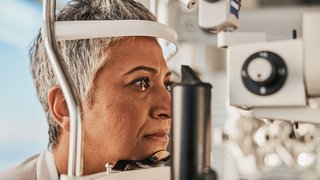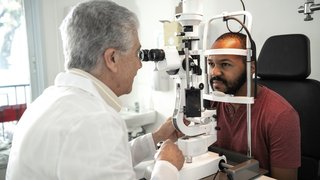Partial-Thickness Corneal Transplants: A Road to Faster Recovery
April 9, 2025

What is the Cornea?
Your cornea is often called the “window to the world” because it is the clear first layer of the eye that light enters through. It also protects your eye against dirt, germs, and damaging UV light, and works with the lens to produce clear vision.
When Might you Need a Corneal Transplant?
When your cornea is damaged or diseased, it can cause eye pain and blurred or cloudy vision. The cornea often can heal itself after scratches or minor injuries, but more serious injuries or conditions may require a corneal transplant to protect and restore your visions – particularly if treatments such as specialty glasses, contact lenses, Intacs, or eye drops do not relieve symptoms.
A corneal transplant, also known as keratoplasty, can treat a number of conditions, including:
- Keratoconus, which causes the middle of the cornea to become thin, bulge outward, and form a rounded cone shape.
- Fuchs’ endothelial corneal dystrophy (FECD), a hereditary condition in which the inner layer cells of the cornea die, causing the cornea to swell and thicken.
- Infections that cause inflammation or damage to the cornea.
- Traumatic injuries that damage and scar the cornea.
In a traditional corneal transplant, known as penetrating keratoplasty, the surgeon cuts through the entire thickness of the cornea to remove a small disk of the damaged or diseased cornea. Think of it like removing a manhole cover. We then stitch a healthy donor cornea in its place.
This type of corneal transplant is the best option when the damage extends through all layers of the cornea or scarring has set in.
Patients used to have to wait a year or longer after transplantation before their sight fully returned. But a new, less invasive procedure called partial thickness keratoplasty offers a faster recovery and higher success rates.
Partial Thickness Corneal Transplant: A Less-Invasive Technique
UT Southwestern was the first medical center in the Metroplex to adopt the new approach. Instead of replacing the entire cornea, we can replace just the layers of damaged tissue. Each layer is just 15 to 25 microns thick – approximately one-thousandth of a millimeter. For perspective, a human hair is about 70 microns.

The type of partial thickness corneal transplant you need depends on which layers need to be replaced:
- Deep anterior lamellar keratoplasty (DALK) replaces the middle and outside layers of the cornea.
- Endothelial keratoplasty replaces the innermost layer of the cornea, known as Descemet’s membrane.
There are several advantages to partial thickness corneal transplants, including:
- A small incision and fewer sutures allow quicker healing and less risk of infection or wound rupture.
- A thinner layer of foreign tissue in the body means a decreased risk of the body’s defense mechanisms fighting the tissue.
- Vision recovery may only take a few weeks to months, compared with a year or more for a full thickness corneal transplant.
Your ophthalmologist will work with you to choose the best surgical method depending on the cause of your cornea damage and your unique needs. Above all, we want to protect and restore your vision.
Clear Vision in Sight for Corneal Transplant Patient
Glenda Marshall struggled for decades with thick glasses and foggy vision. Following a corneal transplantation she received at UT Southwestern, she’s seeing better than ever.
What to Expect During a Partial-Thickness Corneal Transplant
We can use monitored anesthesia care, or MAC, for partial thickness corneal transplants, which means you’re still aware of what’s going on but very relaxed. The level of sedation will depend on your individual needs.
Your surgeon will make a small incision at the edge of the cornea, through which they will remove the diseased or damaged layer and implant the healthy donor tissue using a device that is similar to a syringe.
The layers we are replacing are only 15 to 25 microns thick. We stain the layers with an ophthalmologic blue dye and a fine stamp so we can position them correctly in the eye.
With a DALK, a similar number of stitches to a penetrating keratoplasty will hold the new layer in place. But in endothelial keratoplasty, an air bubble is placed behind the donor cornea to hold it in place. You’ll need to lie on your back for a few days, except to eat or go to the bathroom, to allow the new layers to adhere to your own cornea. You'll also wear a protective shield over the eye while you sleep for about a week.

The Future of Corneal Surgery
We have made great advancements in eye care over the years, giving patients better vision through less-invasive methods. And we’re always looking to improve.
For example, my colleague, V. Vinod Mootha, M.D., is working to better understand the underlying genetic cause of FECD, which makes the cornea swell. In 2018, he teamed up with David Corey, Ph.D., to research whether small molecules called oligonucleotides can be used as a treatment for people who are at risk and make them less susceptible to developing FECD.
Next on the distant horizon for corneal transplantation is the possibility of injecting cells into the eye to regrow damaged tissue. If we can use cells from the patient's own body, we could potentially eliminate the need for cornea donation and/or invasive corneal transplant procedures.
For now, it’s important to take care of your eyes and keep your annual eye exams. Routine visits to the ophthalmologist are critical to preserve, restore, and prevent vision loss.
If you are experiencing eye pain or a change in your vision, visit an eye doctor as soon as possible. The earlier we detect a problem, the more options you'll have to treat it or slow its progression.
Your vision is too important to delay care. To visit with an ophthalmologist, call 214-645-2020 or request an appointment online.











